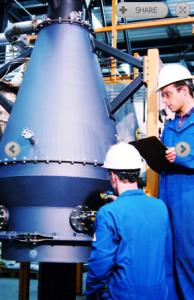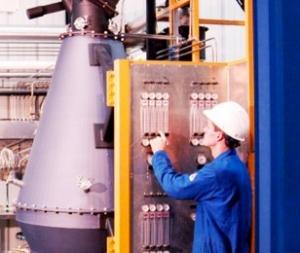
Being known as the world's energy hog makes the U.S. military squeamish; it's common knowledge that the Army, Navy and Air Force spend $15 billion a year using 360,000 barrels of oil a day. This voracious burn rate, shaped by earlier decades of cheap oil, makes the Pentagon the single largest oil consumer in the world.
After finally admitting to its "Betty Ford-sized " dependence on energy - and oil in particular - cold turkey has been the DoD's order of the day since the 2010 Quadrennial Defense Review addressed energy as a strategic issue.
Fortunately, serial entrepreneur Mike Hart thinks he can help the military end its energy addiction. In a former Air Force hangar outside Sacramento, Sierra Energy, the company he founded in 2004, has been testing a waste-to-energy system called the FastOx Pathfinder, a gasifier shaped like a svelte Mercury space capsule, which, pound for pound, happens to contain one of the most powerful blast furnaces on earth.
Hart's first customer: the U.S. Army
Unlike other biofuel gasifiers that burn only presorted waste, this furnace can heat all kinds of trash to 3,000-4,000?F, including anything from worn tires and old iPods to grass clippings and even raw sewage. Without combustion, this creates syngas, which can then be burned to generate electricity or made into ethanol or diesel fuel. Here's a short company demo:
Several years ago, Sierra Energy joined a Pentagon incubator program used to push innovative concepts all the way to production. Results at this DOE test facility have been promising. Inside the FastOx, one ton of waste creates enough gas to produce 42 gallons of renewably sourced fuel and 580 kilowatt-hours of electricity - enough to power a home for a month and a half - with just one-third the emissions of coal. And one FastOx gasifier is ready for delivery to Hart's first "motivated" customer, the U.S. Army.Providing base energy security
Now that the Pentagon knows that the gasifier works as well as Hart promised, in early 2014 it will be making electricity and fuel for vehicles and generators at Fort Hunter Liggett, a training base in Monterey County, Calif.
After learning an expensive and deadly lesson in the Middle East, military Brass plan to use the gasifier in isolated outposts, eliminating the need to truck fuel over long distances and dangerous terrain. It would also reduce trash-burning, which has created pollution and odors that turned locals against

the American presence in Iraq and Afghanistan.
"The mission drives this," said Ms. Burke, the assistant defense secretary told the New York Times, "and the mission is inherently energy-intensive."
FastOx will also have value for the military stateside. "I have a $24 million-a-year electric bill at Camp Pendleton," said base commander, Vincent A. Coglianese. "If I can reduce that cost, that's more money I can put into training Marines and sailors."
Ms. Burke added, "Something for military operations has to be really rugged, deployable, simple to use - all of those things."
Hart sizes up California's landfills
Military consultants who've looked at the FastOx say it meets those criteria. John Conger, who oversees bases in the U.S., says that while providing long-term savings, Sierra Energy's gasifier also provides energy security for the base during grid failures.
But once the FastOx has proven itself at the Army base in California, Hart has big expansion plans for Sierra Energy. "California produces 30 million tons of garbage a year," he said. "It could meet its oil needs and still export more fuel than some OPEC members." Sierra plans to license or sell its gasifier technology. The first model will be small and cost about $3 million. But Mr. Hart said he expects to sell larger systems to municipalities and biofuel makers that will go for much more.


